Who Is Sebastian Hoeneß?
In recent years, German football has seen its fair share of clubs dropping below expectations and teams surprising people by performing much better than expected.
For example, this season in the Bundesliga, Xabi Alonso’s Bayer Leverkusen are leading the way at the top of the table, going unbeaten in their opening 15 league games.
Then, we have Union Berlin, who, despite finishing seventh, fifth, and fourth in the past three campaigns respectively, currently find themselves in 16th place, having won just three games from 14.
One team defying expectations after a lacklustre campaign last season is VfB Stuttgart, who currently sits in fourth position in the UEFA Champions League spots, eight points off the leaders.
Die Roten narrowly escaped relegation from Germany’s top flight last season, mainly thanks to the appointment of Sebastian Hoeneß, who joined the club with eight games remaining and was tasked with keeping the club up.
Somehow, Hoeneß achieved this by going unbeaten in those eight games, finishing in the relegation play-off spot, which his team also won.
This season, they are on course for their best season since 2017-18 when they finished seventh.
This scout report will provide a tactical analysis of Sebastian Hoeneß tactics at Stuttgart from this season, with the analysis using data and match footage to highlight key aspects of his tactics.
Sebastian Hoeneß Coaching Style & Formations
The 41-year-old former attacking midfielder started his managerial career at Bayern Munich’s second team back in 2019-20, where he impressed enough to earn the manager’s job at Hoffenheim, leading them to two mid-table finishes.
The clubs’ leaders considered this a failure—they had European aspirations due to finishing sixth the season before Hoeneß’s arrival, and the two parties parted ways.
Almost a year after his departure from Hoffenheim, Hoeneß was hired as Stuttgart manager.
He was tasked with taking the club back up the table after several underwhelming campaigns in the bottom half.
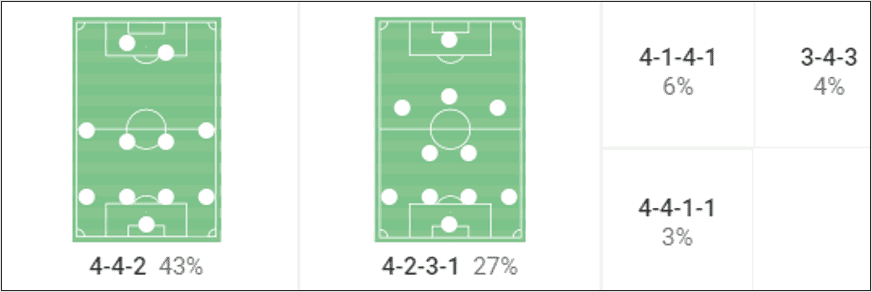
Hoeneß has mainly used two formations this season — the 4-2-3-1 and, more frequently, especially recently, the 4-4-2.
There have been cameo uses of 4-1-4-1, 3-4-3, and 4-4-1-1.
Stuttgart’s use of a 4-4-2 may surprise some, as few possession-controlling teams use that formation. However, Hoeneß’s approach is unique.
Sebastian Hoeness Tactics – Mid-block with a triggered press
Off the ball, Hoeneß likes his Stuttgart side to be confident and proactive, just as they are in possession.
This involves reacting positively when possession is lost and setting up to gain the ball when the opposition has settled possession.
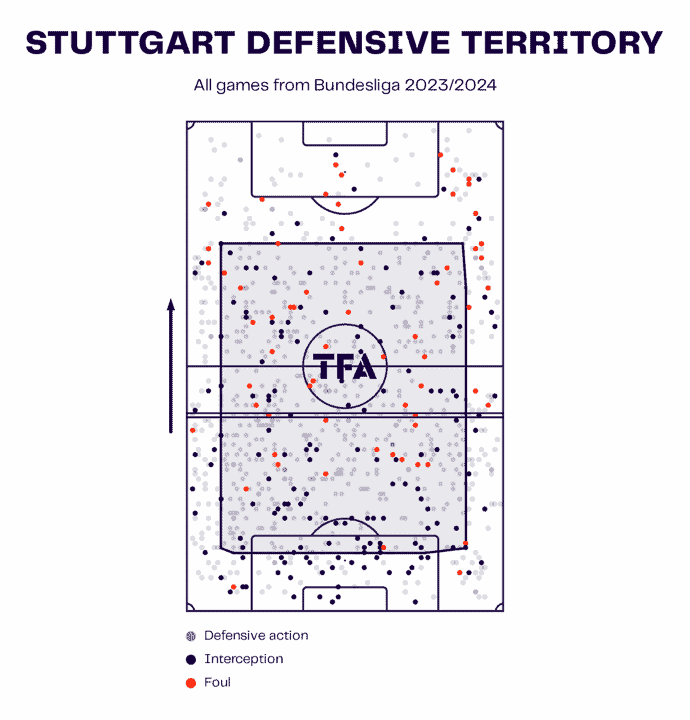
The visual above gives us an idea of their defensive approach. It shows us where they are more frequently active and where their defensive line sits, which helps their rest defence positioning.
We’ll discuss Stuttgart’s pressing intensity shortly, but their rest defence allows them to execute a counter-press in the event of a turnover and subsequent opposition attacking transition.
One positive noteworthy aspect is the discipline that Sebastian Hoeneß has instilled throughout the squad, which is evident by their low foul rate, especially in and around their own box.
This season in the Bundesliga, at the time of writing, Stuttgart averaged 8.79 fouls per 90 — the division’s fourth-lowest rate.
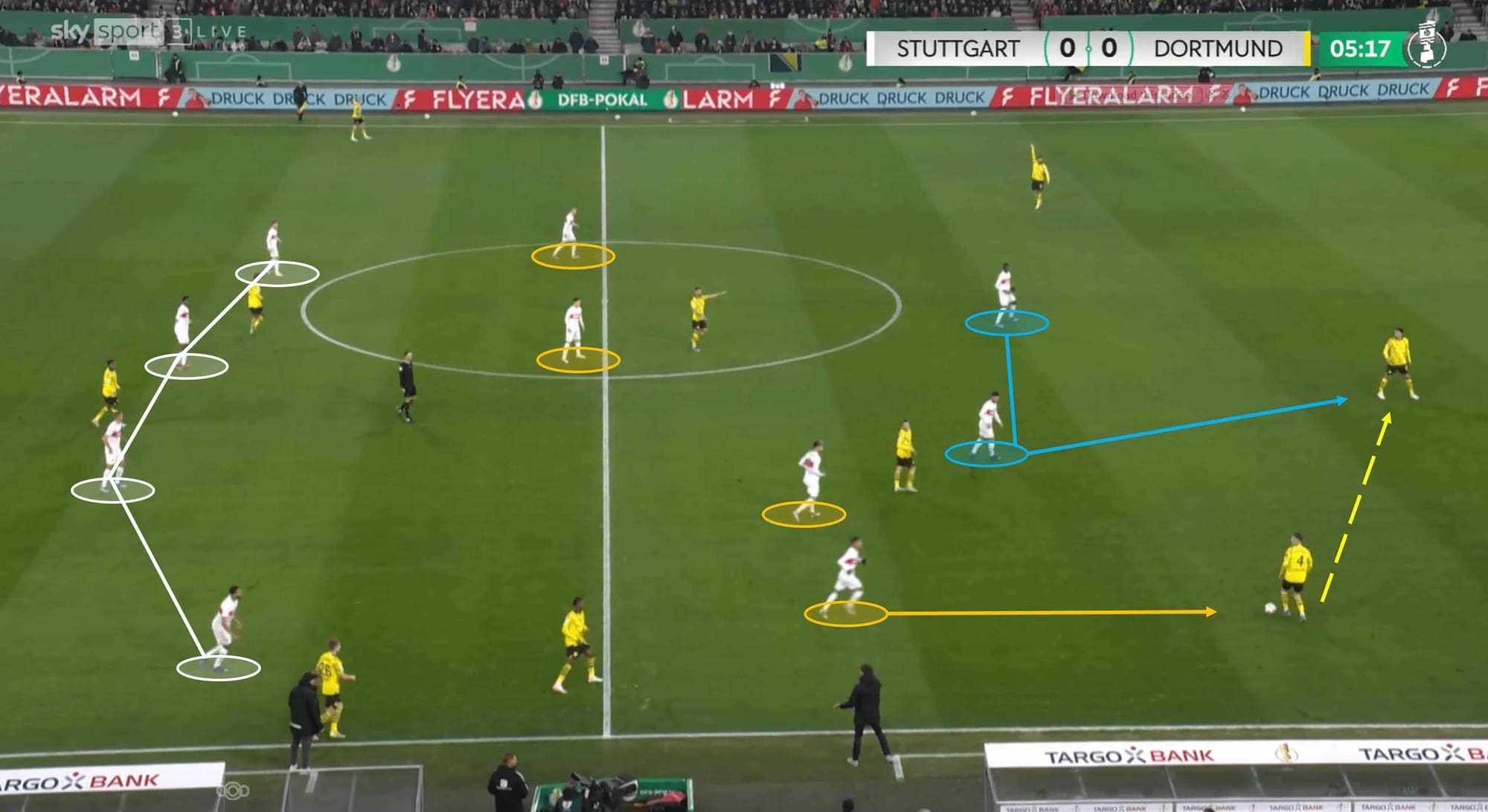
Now, we will discuss Stuttgart’s mid-block to combat the opposition’s attempt to build momentum on the ball.
There are several things to note here, starting with the back four — compact, opposite full-back tucked in to help shrink the space available in dangerous central areas, and the near-side full-back man-marking the opposition winger.
The midfield unit operates slightly differently and often simply reacts to the situation at hand.
The fundamentals remain the same, though — the far-side winger tucking in slightly to do the same job as the full-back on his side while the near-side winger presses the opposition full-back.
The two central midfielders mark the opposition’s passing options in central areas to limit or eliminate that route of attack.
The front two often remain central in the initial moments before reacting according to the situation that unfolds, which we will dissect in more detail below.
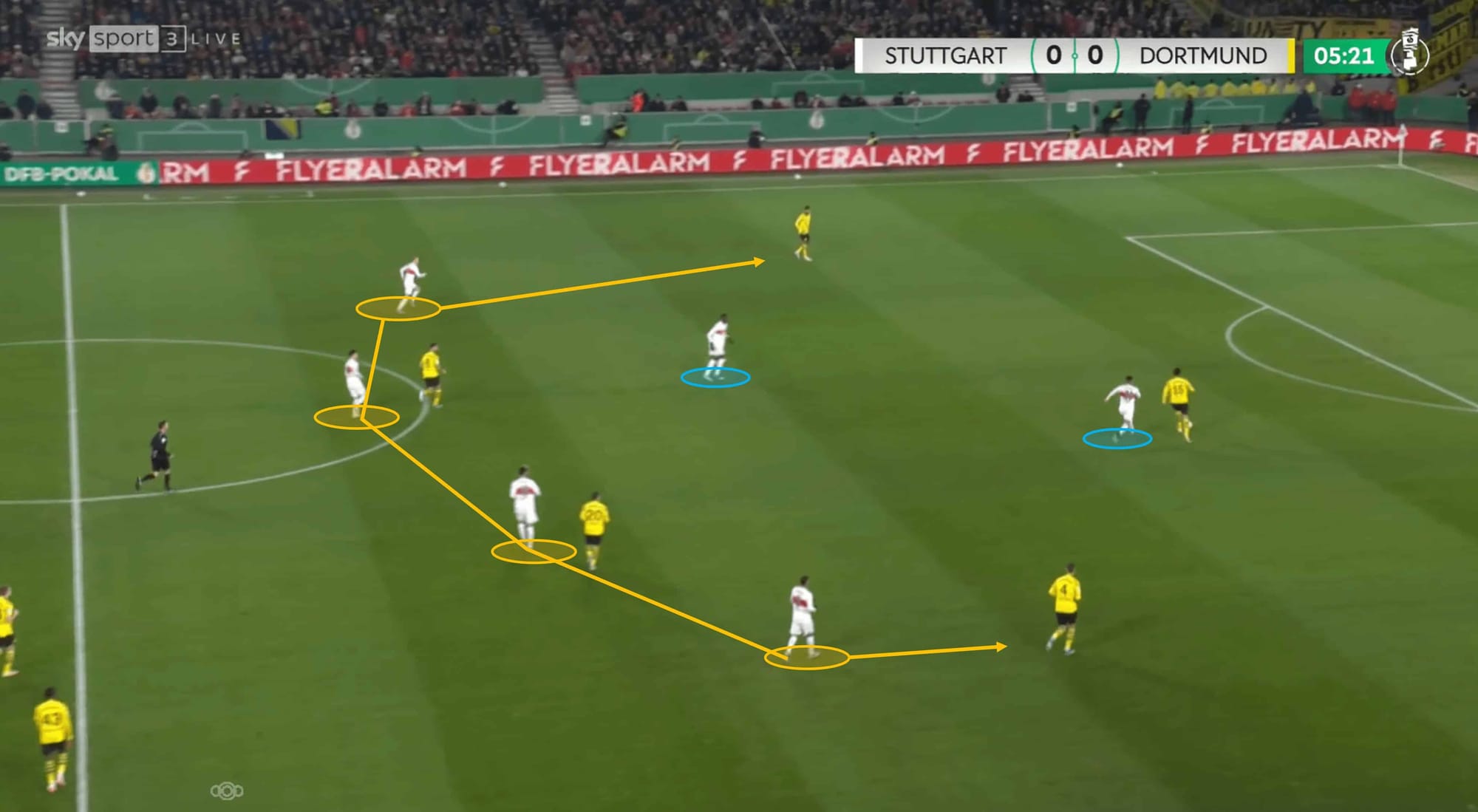
The front two become active as the Dortmund left-back is forced to play backwards, thanks to the Stuttgart shape and reaction.
Precisely, the near-side CF will close down the opponent on the ball with high intensity, while his striker partner will do one of two things, depending on the opposition’s presence: he will either mark the deep midfielder/extra CB to eliminate them as a passing option or, as you see in the image above, will sit in between the pressing forward and the midfield unit, awaiting a stray pass or the event of a turnover.
This particular example encompasses what Hoeneß wants to achieve with these tactics.
The opponent on the ball makes the pass to his teammate at RB, which triggers the press of Stuttgart’s left midfielder.
The centre midfielders and defensive unit step up to add to the mounting pressure.
Dortmund then tried to play out quickly down the right flank, but Stuttgart’s quick reactions enabled a turnover and a subsequent transition.
This approach makes it difficult for the opposition to build attacks from the back, which most definitely contributes to Stuttgart’s strong defensive output.
At the time of writing, they have the league’s fourth-best defensive record in terms of goals conceded (19) and second-best in terms of xG against (21.4).
Their challenge intensity sits at 5.5, the sixth-highest in the Bundesliga, a good insight into their aggression off-the-ball.
Sebastian Hoeneß Style Of Play – Passing variety
Possession-based teams may be dominant on the ball, but they can sometimes be one-dimensional, tactically speaking.
Hoeneß has found a way to control possession while remaining somewhat unpredictable and intense by consistently utilising a wide variety of passes.
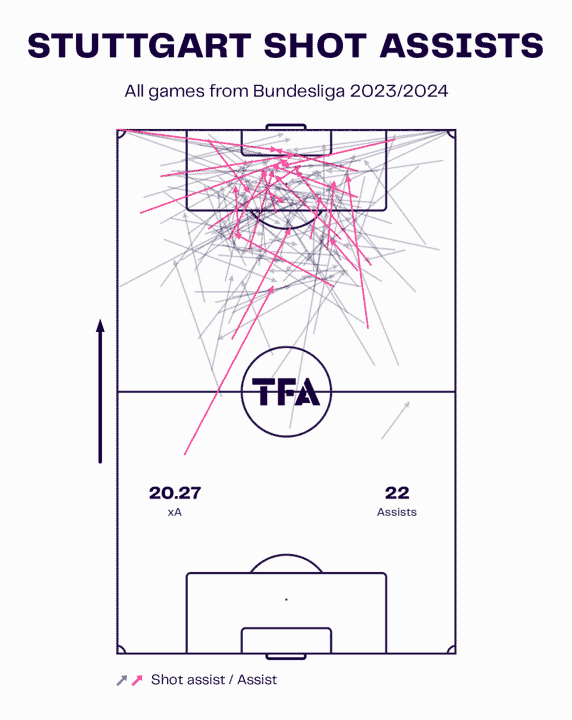
Hoeneß likes his team to be capable of creating chances from a multitude of areas and situations, which can be challenging to defend against due to the difficulty in preparing for such tactics.
Not only do they like to create chances from wide areas via crossing, but they are also well-accustomed to setting up chances from central areas, with plenty of assists finding their way into the box from midfield zones via through balls.
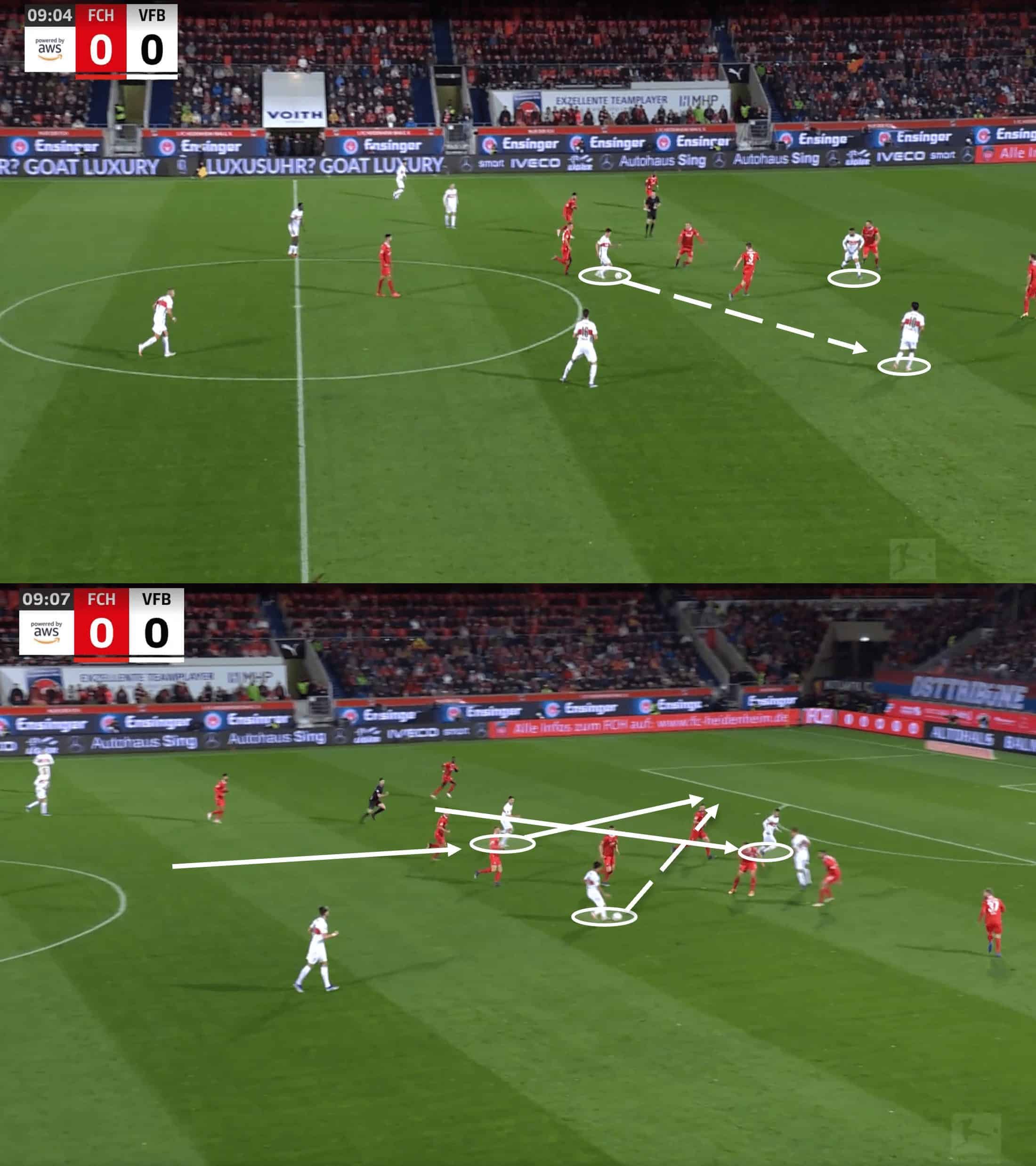
Stuttgart’s heavy use of through-balls is, in some way, refreshing to see — it involves a certain level of risk that you don’t sometimes get quite as often with possession-based teams.
They average 7.4 through passes per 90 (fifth-highest in the league), with an accuracy rate of 39.3%, which is right up there with the best in German football (third-best in Bundesliga).
While not leading to a goal, this particular example highlights some essential elements of Hoeneß’s attacking tactics.
The midfielder on the ball in the top image is quick to recognise his teammate in plenty of space and releases the ball to him immediately.
But, as you can see in the bottom image, the passer does not sit deep, instead making a bursting run forward, looking to get beyond the opposition’s back line, where there is a big gap.
This gap was created by the panic caused by the off-the-ball movement of other Stuttgart players.
While the chipped pass into this space was not successful on this occasion, Stuttgart created a chance by manipulating the opponent’s positioning while also using runs from midfield to add to the chaos.
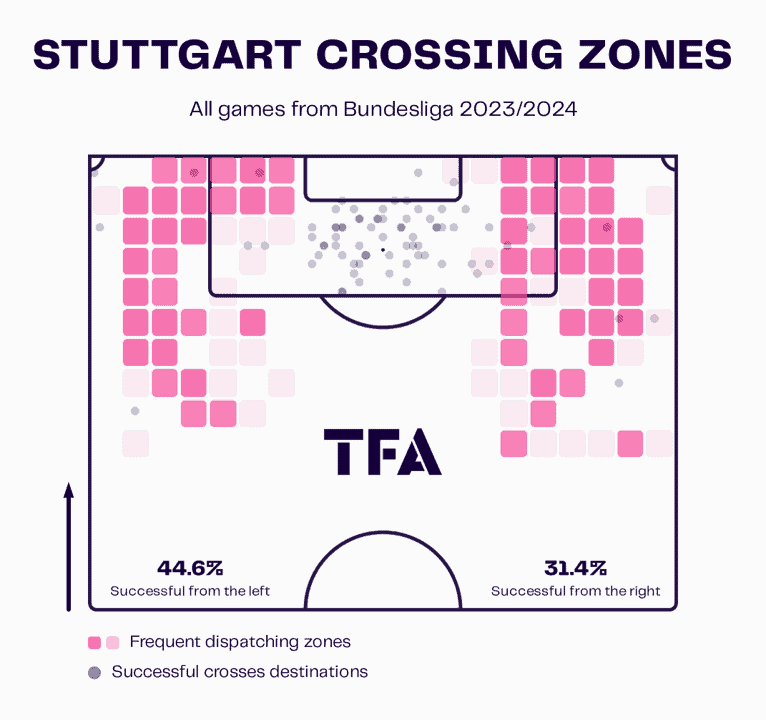
As mentioned earlier, Hoeneß recognises the importance of being effective from crossing situations.
His Stuttgart team is instructed to deliver from either flank when the opportunity arises—the box will most likely be packed with multiple attacking options.
It isn’t a staple of their attacking tactics, with their average of 12.49 crosses per 90 falling below the league average.
Still, they have
evident ability in this area—their cross-accuracy rate of 37.9% is the fourth-highest in the Bundesliga.
The aerial quality is also in the box, with Hoeneß’s side scoring six headed goals.
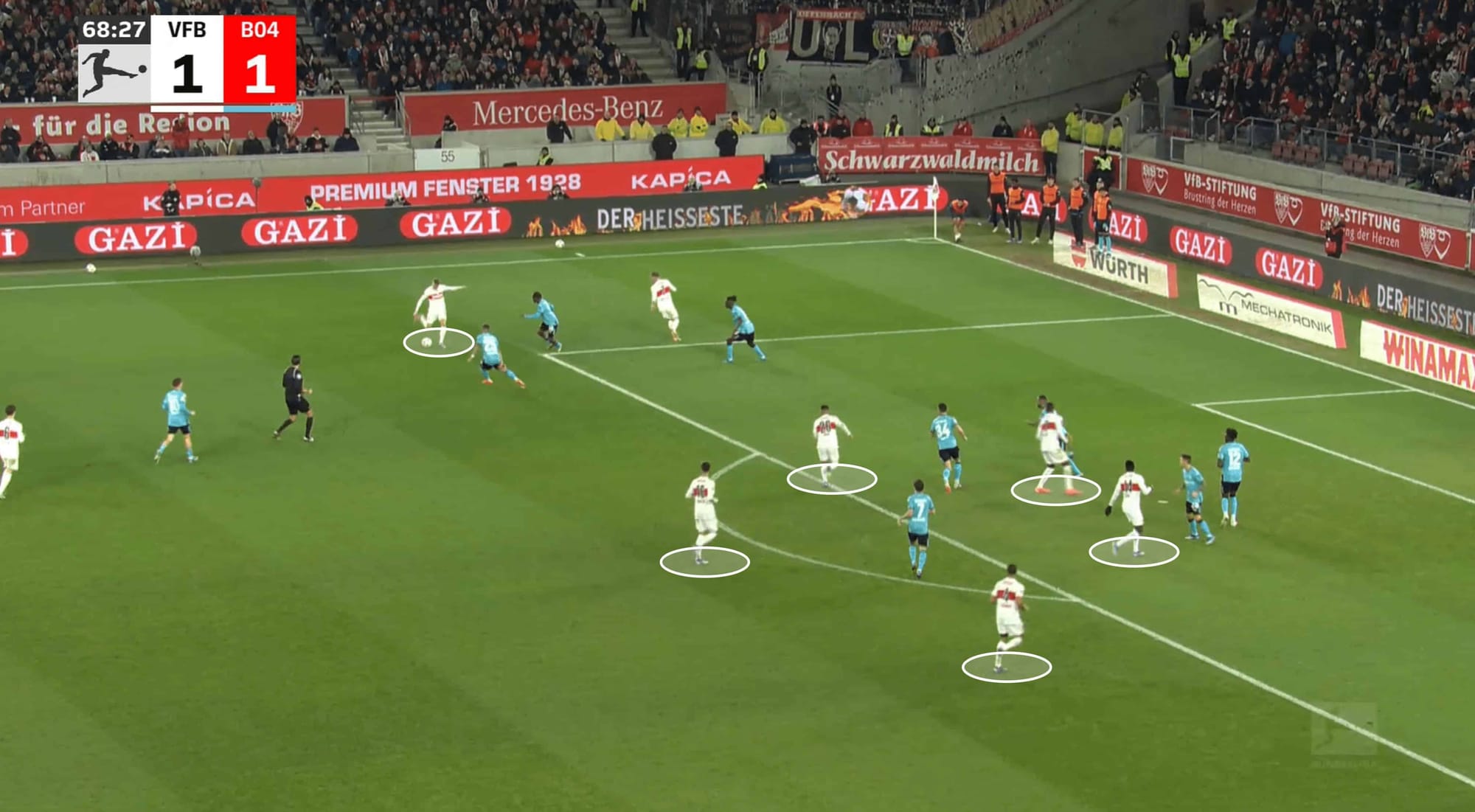
And this is what you can expect to see in a crossing situation from Stuttgart.
There is usually a close supporting teammate to the crosser himself, but there is also a strong box presence, as in the image above.
It is also necessary to recognise the presence at the edge of the box—two players sat ready to react if the ball comes their way.
One of them (the bottom highlighted player in this example) is usually their right-back (or left-back on the opposite flank), who has the instructed licence to get forward and support crosses.
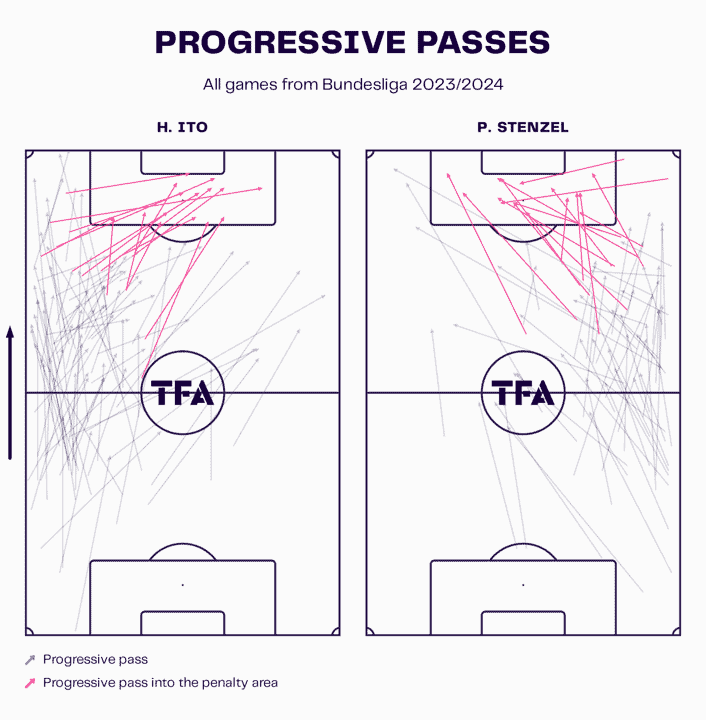
Every team uses progressive passes.
Some use them more frequently in different areas than others, and some are better than others.
Stuttgart is one of the teams that thrive with progressive passes—averaging 73.69 per 90 is matched by nobody in the Bundesliga, and their accuracy rate of 76.2% is the fourth-best in the league.
While we do see Hoeneß’s men use these from central areas, of course, their full-backs are the most frequent and effective with their use.
As you can see above, not only are Hiroki Ito (LB) and Pascal Stenzel (RB) capable of progressing forward down the flank or through central areas of midfield, but they both have a knack for making these types of passes into the penalty area.
Ito averages 11.45 progressive per 90 (sixth-highest in the league), while Stenzel contributes 10.67 per 90 (12th highest).
Sebastian Hoeneß Manager Style – High attacking presence
One of Stuttgart’s most dangerous weapons is their presence and fluidity in attack.
While they are one of the most dominant teams in the league for possession (averaging 57% per game, 4th highest in Bundesliga), they like to have a good, fast pace to their play, as evidenced by their passing rate of 15.9, which is the league’s fourth-highest.
Not only are they quick in moving possession, but they also like a high presence in attack, with midfielders often joining the action in the final third.
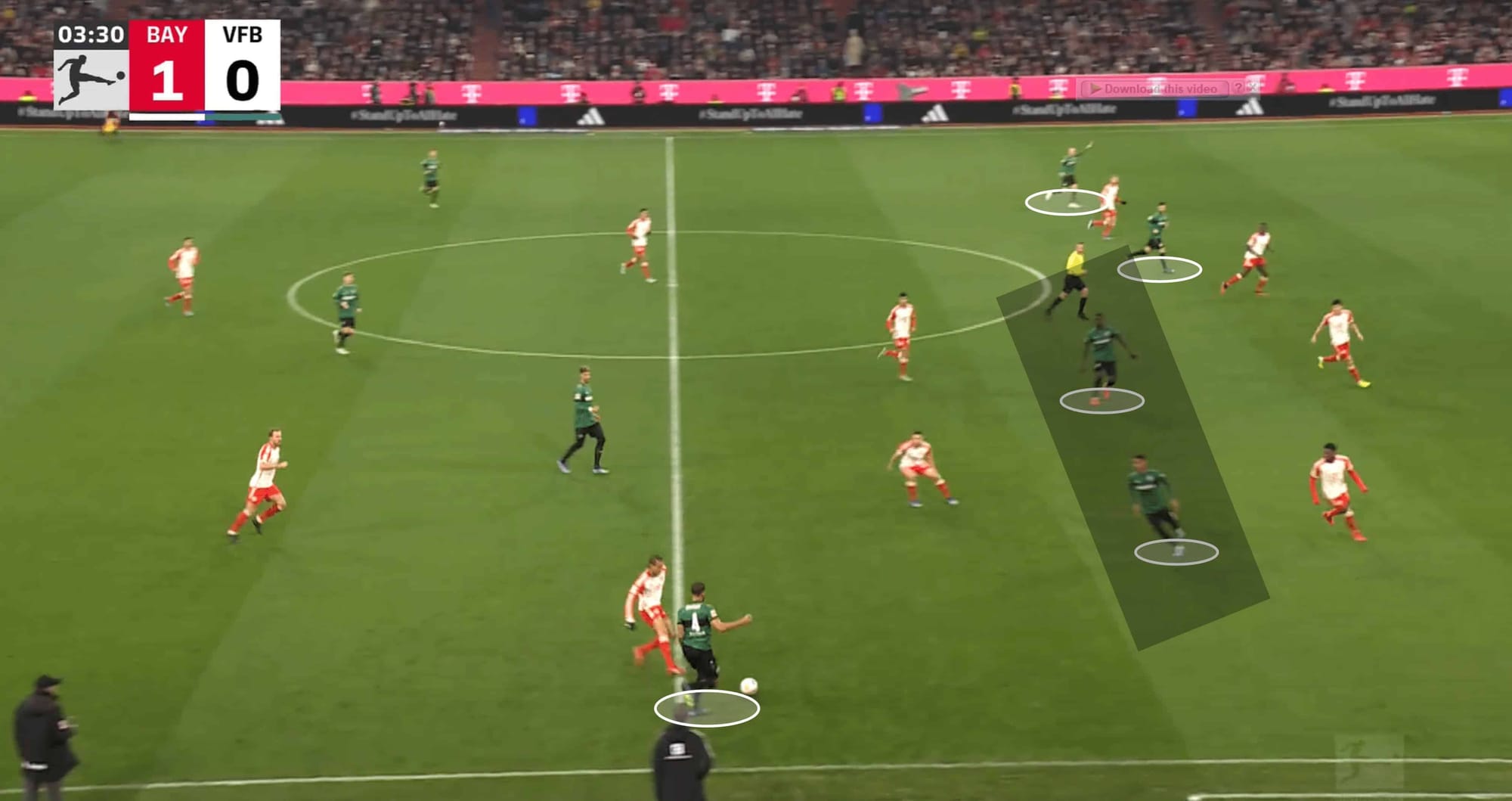
This first analysis image shows that attacking courage and intensity.
Against Bayern Munich, one of Europe’s top teams, Hoeneß shows absolutely no fear and no tactical compromise.
A trademark move of Stuttgart’s build-up — the full-back collecting the ball around the halfway line and looking to move the ball into high central zones.
The attacking presence is the most noteworthy and the main point of this particular portion of the analysis.
Despite Bayern’s high line, Stuttgart has four men not only ahead of the ball but also behind the Munich midfield, essentially creating a 4v4 if they can make the pass into the middle count.
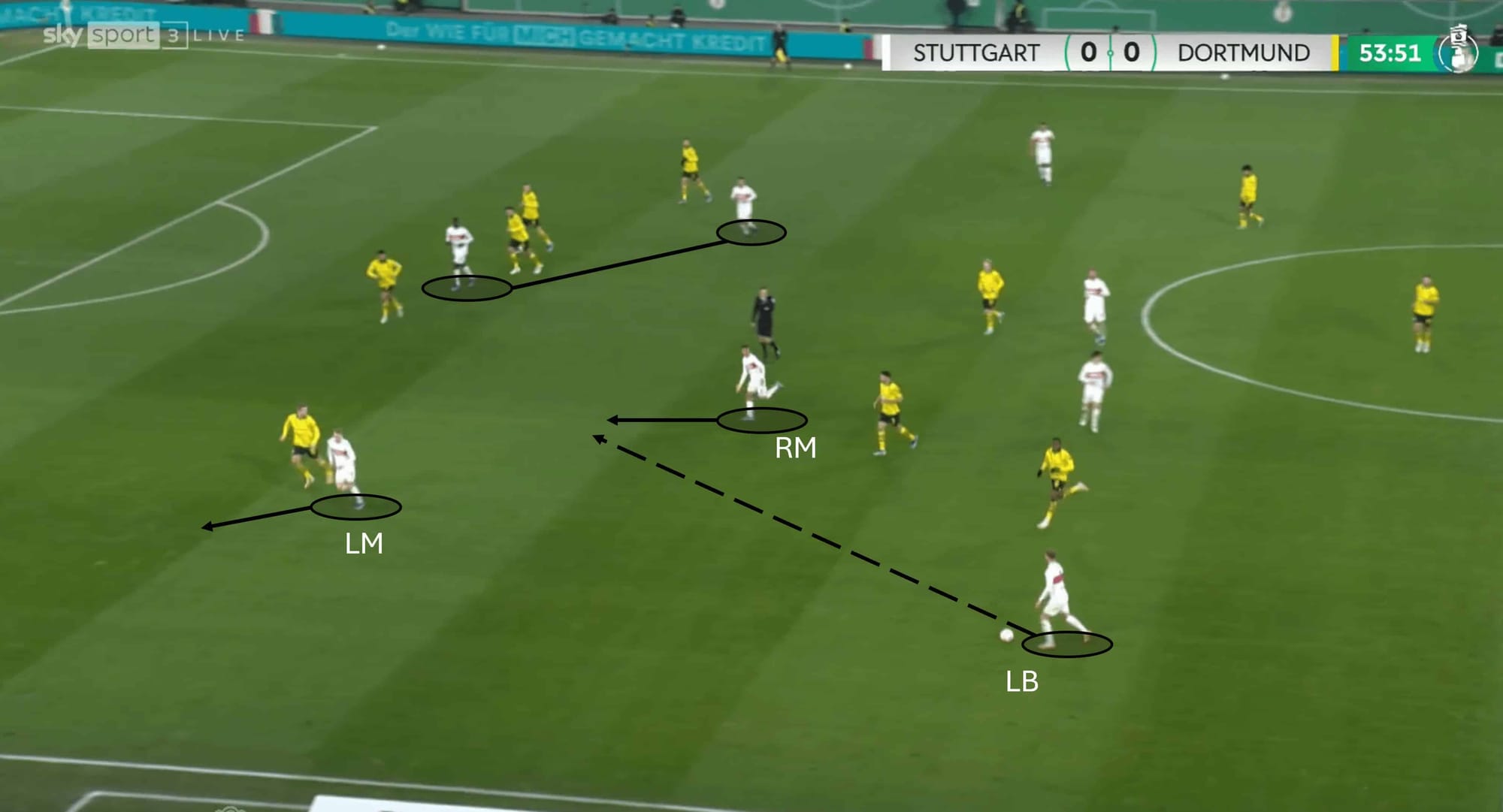
Positional fluidity is another factor in Hoeneß’s tactics. The midfielders have the freedom to make runs into dangerous and vacant spaces, which can often lead Stuttgart to momentarily adopt the characteristics of another formation.
For instance, the example above shows the right midfielder in a central position, making a forward run into space behind the Dortmund midfield — where you would usually expect to find a number 10.
If the positions weren’t labelled, you’d be forgiven for thinking that they’re playing a 4-3-3 — as you can imagine, this can cause all sorts of issues for the opposition defence.
The presence of the RM in that area means the front two can focus on positioning themselves in preparation to receive the ball later in the attack.
Clinical forward Serhou Guirassy eventually makes a run in behind the defence after the RM receives the ball.
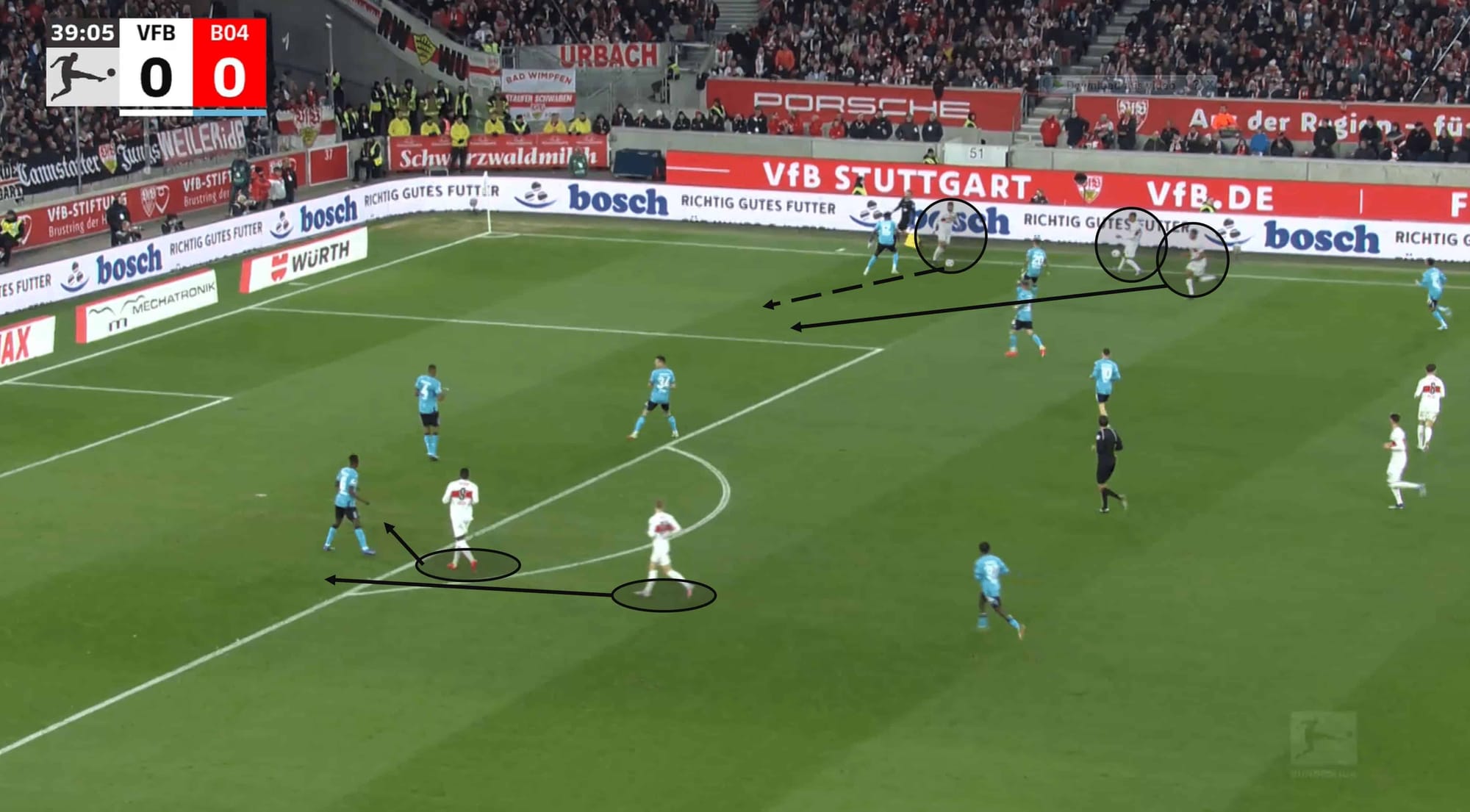
High attacking presence can come in numerous forms, as Stuttgart demonstrate above.
Two attacking players are lurking at the edge of the box, and three players close to each other on the right flank are looking to execute a quick combination to get into that space behind the opposition defence and head toward the byline.
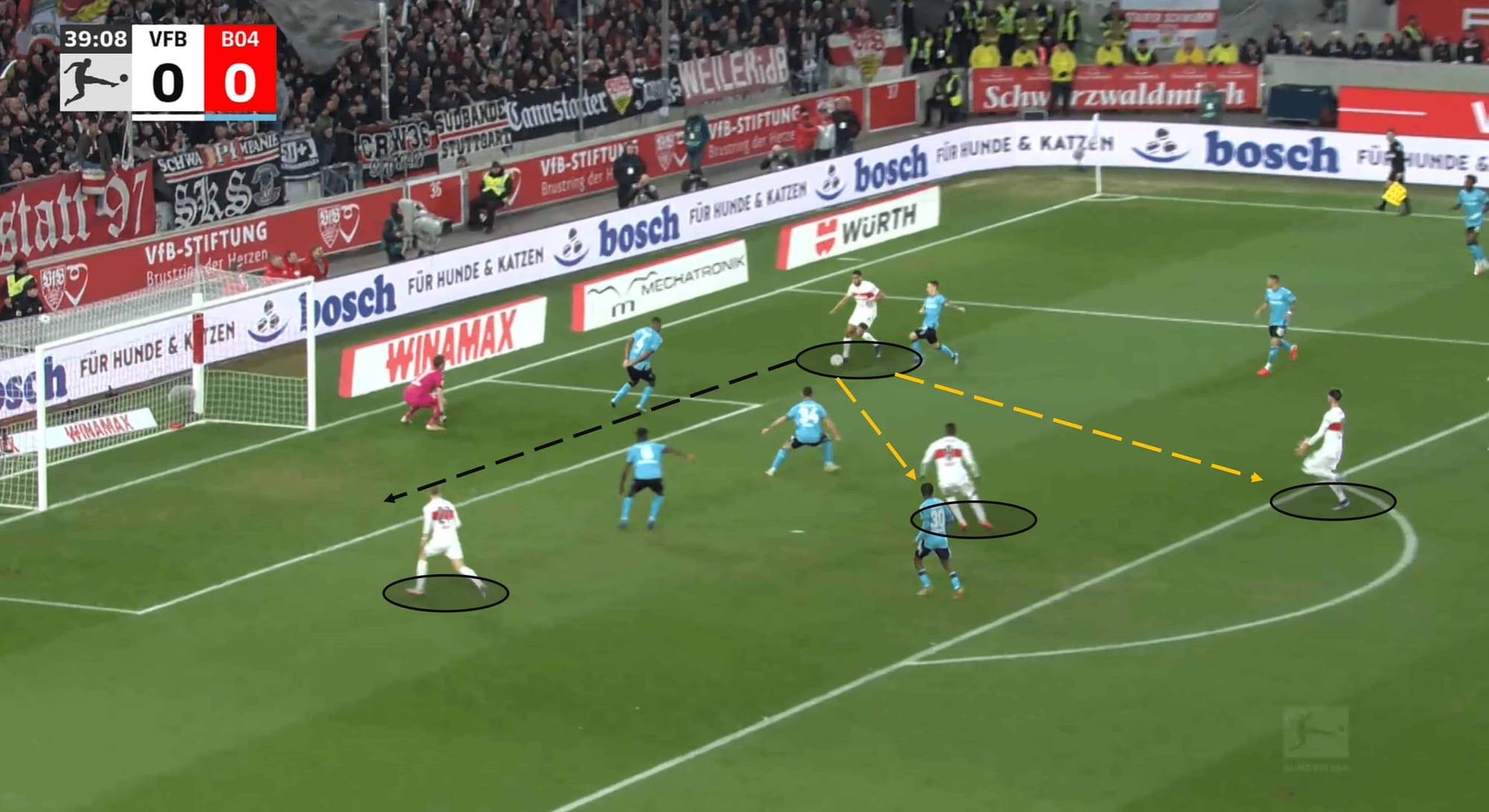
That pass was successfully placed into space, allowing the Stuttgart man to make his excellent run count by taking the ball inside the box.
And in that moment, we get another example of good attacking movement — three examples, actually.
One is the midfielder at the edge of the box with no opponents anywhere near him; the second is Guirassy, who initially made a forward run but cut inside and peeled away from his marker to become free just before the penalty spot, and the third one is the player at the far side — he and Guirassy split their runs at the same time, making it difficult for the Leverkusen defence to react quickly enough to mark them both.
This created space for the well-threaded pass through the bodies across the six-yard box, providing the easiest tap-in.
Conclusion
Time will tell if Sebastian Hoeness tactics can keep his Stuttgart side performing at such a high level long enough to earn European qualification.
While that is not currently a totally unrealistic occurrence, at the start of the season, likely, Stuttgart fans could only dream of a top-four finish, yet they’ll be revelling in being the entertaining side that Hoeneß has transformed them into.






Comments